10 Greek islands to visit after the pandemic
Last week, it was announced that Cyprus would soon allow fully vaccinated British tourists into the country without any restrictions, such as the need for a negative COVID test or quarantine on arrival to the island. Meanwhile, other countries, Greece included, are keen to establish vaccine passport systems, to facilitate international travel. Hopefully, such a system will be in place before the summer, so we can travel safely and responsibly. In anticipation of this, here is my list of 10 Greek islands to visit after the pandemic:
-
Serifos
The Cyclades is a group of islands in the Aegean Sea, so close to each other (island-hopping, anyone?) and yet so different. Located in the western Cyclades, south of Kythnos and north of Sifnos, Serifos has a small population of just over 1,000. Due to its close proximity to Piraeus, the port of Athens (2 hours by ferry), the island comes to life in the summer, when Athenians seek to escape the heat of the capital. Popular among the Greeks, but relatively unknown to most foreign travellers, Serifos was not as badly affected by the pandemic last summer, and hopefully it won’t be adversely affected this summer either.
Like with many other Greek islands, Hora is the name of the capital of Serifos. Built on the slopes of a hill, it is a whitewashed village overlooking the port of Livadi and all the while offering panoramic views of the Aegean Sea.
Despite being a relatively small island, Serifos has over 70 beaches. One of the most famous and my personal favourite is Agios Sostis. This east-facing beach, which takes its name from the chapel overlooking the small bay, is neither organized nor has any facilities (whether a beach bar, tavern or even a canteen), so make sure you bring a beach towel, a book, food, and water if you are to spend the day there.
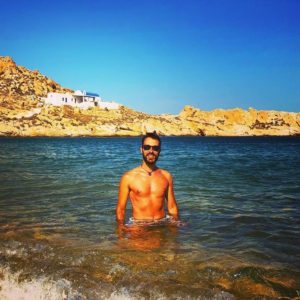
For more tips on Serifos, check out my post ‘Serifos: the Greek island where time stands still’.
2. Sifnos
From Serifos, you can take the ferry to the neighbouring Sifnos. Despite being so close to each other, Sifnos has a very different vibe compared to the laid-back Serifos. Not only a gourmet island, it is also a very chic one. Does this sound like Mykonos? Trust me, Sifnos is neither as pretentious nor as hedonistic as Mykonos.
With a small population of just under 3,000, Sifnos has plenty of villages worth visiting: Apollonia (the capital), Ano Petali, Artemonas, the cliff-top Kastro, and Kamares (the port). Then it has a decent number of (more than decent) beaches (guess this is what most people sign up for): Herronisos, Hrysopigi, Platys Gialos to mention just a few.
Sifnos also has a very large number of Greek Orthodox churches and chapels: more than 360 scattered all around the island. One of my favourite (and probably the most Instagrammable spot on the island) is the Church of the Seven Martyrs. Sat on a rock, it reminded me of the Church of Agios Ioannis Kastri, on the island of Skopelos, where Meryl Streep got married to Pierce Brosnan in Mamma Mia!
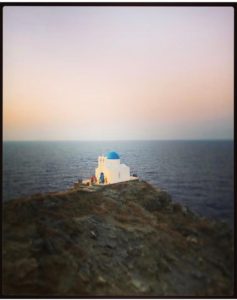
For more tips on Sifnos, check out my post ‘Sifnos: the island of Greek gastronomy’.
3. Folegandros
If you want to continue island-hopping, then consider taking the ferry to Folegandros. This is one of the smallest Cycladic islands, located in the southern Aegean Sea, nestled between Milos and Kimolos on the west, and Sikinos and Ios on the east. Relatively unknown to foreign travellers, Folegandros is only an hour away (on the ferry) from the world-famous Santorini.
Folegandros has a small population of fewer than 1000 inhabitants. Every summer, however, it comes to life thanks to a wave of mostly Greek, young, hipster and arty visitors, who seek an alternative, more authentic and less crowded destination than Santorini.
Built on the edge of a 200-meter high cliff, Hora is the capital of the island and where the heart of Folegandros beats. Ditch your map (if you have one) and simply wander around the village taking in the friendly atmosphere. Colour-coded tables and chairs from the inviting taverns in the squares of the village provide a picture-perfect backdrop. Then, stroll around Kastro, the oldest part of Hora, before you make your way to the church of Panagia.
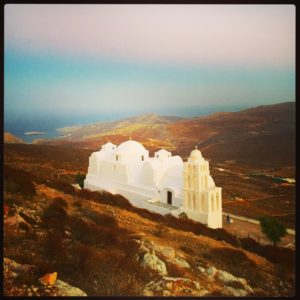
For more tips on Folegandros, check out my post ‘Folegandros: the secret alternative to Santorini’.
4. Santorini
I guess it’s now time to visit Santorini. At the end of the day, this small volcanic island (also known as Thira) is one of the most famous, Instagrammable and visited Greek islands for a very good reason.
There are two main settlements on the west coast of the island, Oia and Fira. Built on a steep slope of the caldera, these two hilltop villages are perfect locations to watch the sunset. Oia, however, is the most charming of the two.
My advice is to get there early in the morning, as this is when it tends to be at its quietest. Wander around the narrow streets and admire the blue-domed churches before you stop at Atlantis Books, a bookstore that is now considered among the must-visit places in Oia. Panagia of Platsani, Saint George and Panagia Agion Panton are among the most beautiful churches and also worth a visit. Then, come back in the evening to watch the sunset.
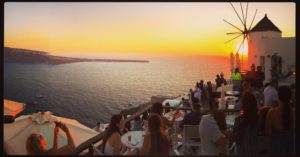
For more tips on Santorini, check out my post ‘Santorini: Top 9 tips by an (almost) local’.
5. Amorgos
From Santorini, take the ferry to Amorgos, less than an hour away. The easternmost of the Cyclades islands may not be as popular as its famous neighbour, but, cliché as it may sound, it is one of the most beautiful and charming Greek islands. In the last few years, it has been popular with the French, since it featured in Luc Besson’s film ‘Le Grand Bleu’ (‘The Big Blue’). It is a medium-sized island (for the Greek standards) with a population of 1,973; it is 18 miles long and 1.5 miles wide at its narrowest and 5 miles wide at its broadest.
As well as its role in the French cult-classic, Amorgos is also renowned for its hiking trails, which not only connect the island’s villages and settlements, but also provide access to ecclesiastical and natural landmarks, and several archaeological sites (Minoa, Arkesini and Vigla). One of these trails, Fotodotis, connects Katapola (the main port) with Hora (the capital and one of the main settlements of the island). This ascending path is rather short and easy, so if your accommodation is at Katapola (like mine was), why not walk to Hora? Start your ascend not long before sunset, so you can watch the sun diving into the deep blue waters of the Aegean.

For more tips on Amorgos, check out my post ‘Amorgos: Top 9 tips by an (almost) local’.
6. Koufonisia
I have to admit that I had never heard of Koufonisia until a couple of years ago. Perhaps, this is because these three Cycladic islands are really really small (as well as the smallest in this list of 10 Greek islands to visit after the pandemic). Actually, only one is inhabited: Ano (or Pano) Koufonisi (‘Upper Hollow Island’). Au contraire, Kato Koufonisi (‘Lower Hollow Island’) and Keros are not. Interestingly, when Greeks say ‘Koufonisia’, they usually refer to Ano Koufonisi, rather than all three. Despite their close proximity to Amorgos and Naxos, these tiny islands are considered remote and often described as ‘hidden gems’, ‘off the beaten track’ or ‘undiscovered paradise’, even for Greeks and Italians, who are the main visitors.
Ano Koufonisi is ideal for beach-hopping. From Hora, the island’s only village which spreads out behind the ferry quay, start walking anti-clockwise towards the beach of Pori. The first stop is Finikas, where a beach bar may tempt you to stay. Inviting as this may be, continue towards Fanos and Platia Pounta. The latter, also known as Italida, is a nudist beach; however, many prefer not to bare it all and still enjoy its golden sand and azure waters. From Italida, walk along the cliff path towards Pori; you will pass by the small caves, one of the most famous sights of the island. Piscina (‘Pool’), or Devil’s Eye, is the one that attracts the biggest crowd – diving from the top of the cave into the naturally formed pool. Continue to Pori and then to the secluded by the caves ‘beach’ Gala.
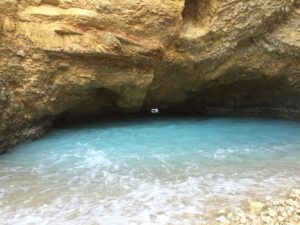
For more tips on Koufonisia, check out my post ‘Koufonisia: Top 9 tips by an (almost) local’.
7. Mykonos
Another confession: I had always thought of Mykonos as little more than a party island destination and a celebrity-magnet. However, the first time I set foot on this Cycladic island, Hora, the capital and main settlement, simply took me by surprise. I remember wandering around the narrow, labyrinthine alleyways, taking pictures of cats napping, or of the blushing bougainvillaeas climbing up the walls of the whitewashed houses, churches and chapels. Even though I am not religious, I was mesmerized by the Church of Panagia Paraportiani and the Life-Giving Spring Orthodox Metropolitan Church. My favourite place on the island is the waterfront of Little Venice, lined with charming bars, where you can enjoy fantastic cocktails and views of the sunset, the windmills and the 18th-century fishing houses.
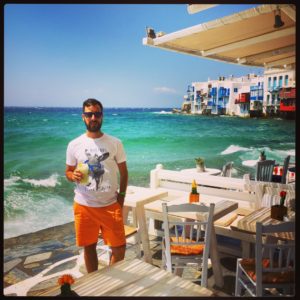
For more tips on Mykonos, check out my post ‘Mykonos: Top 7 tips by an (almost) local’.
8. Paros
From Mykonos, take the ferry to the neighbouring Paros, one of the most centrally located Cycladic islands. Paros is a very well-known island among Greeks, but somehow has managed to escape international attention. In the port town of Parikia, on the north-west side of the island, there’s the Byzantine church Panagia Ekatontapiliani (Virgin Mary with a hundred doors). Then, there’s the Insta-worthy harbour of Naoussa, on the north side of the island. An archetypal Cycladic town, picture-perfect Naoussa is lively and charming. Against a backdrop of white-washed cubic houses, labyrinthine cobblestone cat-laden alleyways and blushing bougainvillaeas, you can savour Cycladic cuisine at its best, followed by late-night cocktails by the sea.

For more tips on the Cyclades, check out my post ‘Island-hopping in the Cyclades’.
9. Kos
For those unfamiliar with the country’s geography, the Cyclades is not the only island group in Greece. Although its name means ’12 islands’ in Greek, the Dodecanese consists of 15 major islands. Of those, Rhodes and Kos are the best-known internationally, and therefore the most popular. As a doctor myself, I have a soft spot for Kos, the island where Hippocrates, the Father of Medicine, was born (around 460 BC) and also began his medical career.
The recently-renovated Archaeological Museum is definitely worth a visit. It is located at Eleftherias Square, opposite the Municipal Market, and housed in a two-story building, erected in 1935, at a time when Kos and the rest of the Dodecanese were still under Italian rule. In the atrium, the floor mosaic depicts the arrival of Asclepios (the God of Medicine) on the island. He is welcomed by other Gods and Goddesses, including Hygeia, who’s holding a snake in her right hand and an egg in her left. Hygeia, whose name means ‘health’ in Greek, was one of the Asclepiadae, the sons and daughters of Asclepios and Epione (the Goddess of healing). Make sure you take a close look at the larger-than-life marble statue of Hippocrates which dates back to the last third of the 4th century BC.
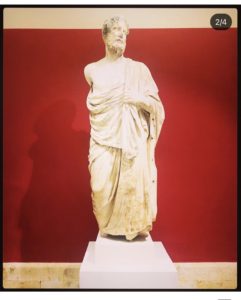
For more tips on Kos, check out my post ‘Kos: the island of Medicine’.
10. Skyros
Of course, I couldn’t not include Skyros in this list of 10 Greek islands to visit after the pandemic. My home-island is located in the centre of the Aegean, east of Evia (or Euboea, the second largest Greek island) and north of the Cyclades. Administratively, it belongs to the Prefecture of Evia, while geographically, it belongs to the Northern Sporades (together with Skiathos, Skopelos and Alonissos).
Every time I visit Skyros, I start my holiday with a swim in the clear blue waters of the Aegean. Molos beach, located on the east coast of the island, is one of my favourites. This is a large organized beach, extending south to the coastal settlement of Magazia and north to Pouria and Gyrismata. Most of the accommodation on the island, from rooms for rent to luxury hotels, is located here. In Molos and Magazia, you will find several beach bars and taverns just a few meters from the sea. Of those, Stefanos is famous for the lobster spaghetti (astakomakaronada), the speciality of the island, while Mylos of Balabanis offers a wonderful view of Hora, the capital and main settlement of Skyros.

For more tips on Skyros, check out my post ‘Traveling around Skyros with a local’.
Further reading
To better prepare for your trip, I would recommend the Lonely Planet Greek Islands Travel Guide.
You can follow one of my two itineraries: Santorini-Amorgos-Koufonisia-Mykonos or Serifos-Sifnos-Folegandros-Santorini.
Alex
(the hopefully-soon-to-be-Traveling-again Psychiatrist)